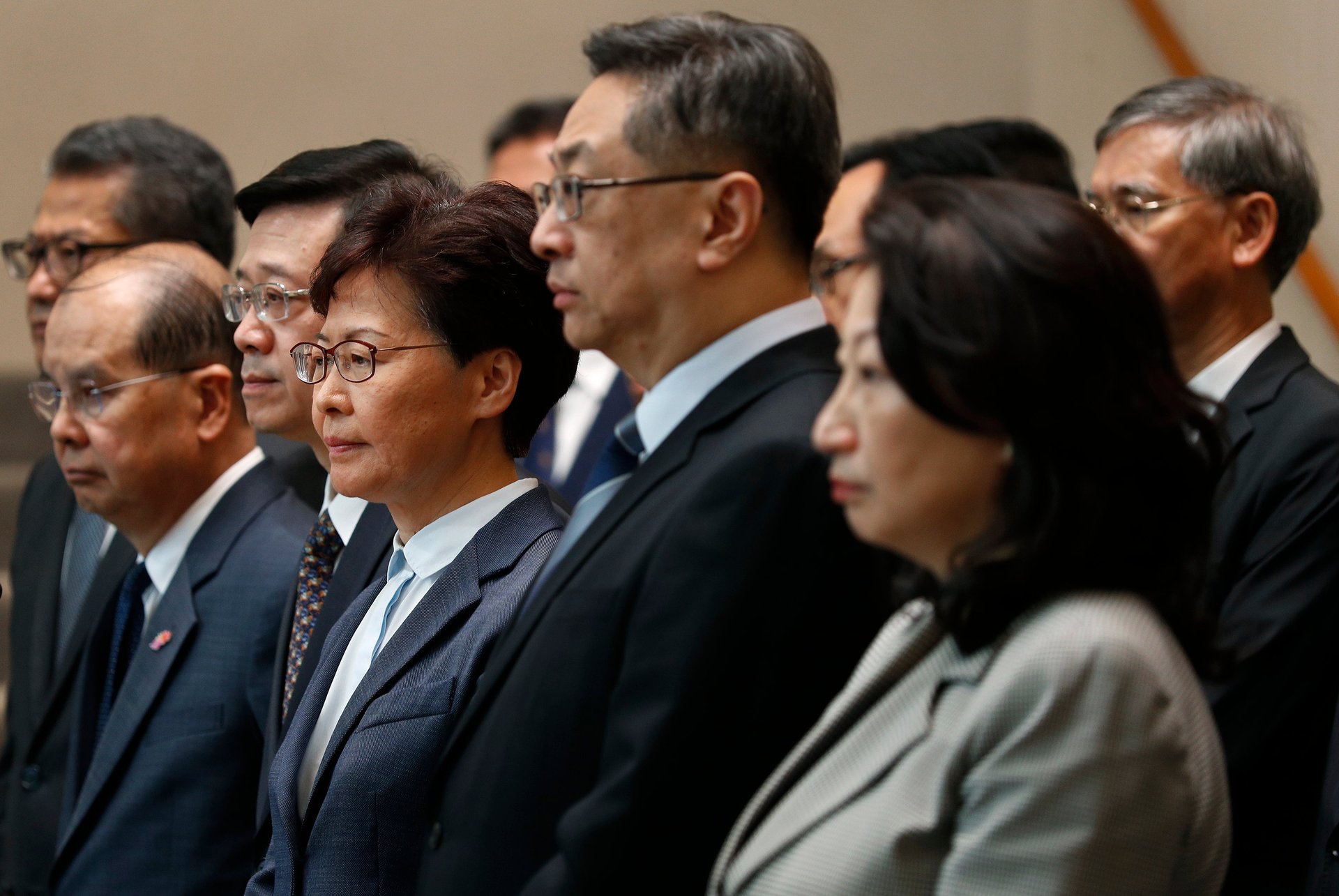Hong Kong’s leader tried to explain why armed thugs were able terrorize the city
A day after a rampaging mob of armed thugs beat protesters and civilians indiscriminately at a train station, Hong Kong’s top official Carrie Lam scrambled to explain why the assailants seemed to have been able to perpetrate the violence with impunity.


A day after a rampaging mob of armed thugs beat protesters and civilians indiscriminately at a train station, Hong Kong’s top official Carrie Lam scrambled to explain why the assailants seemed to have been able to perpetrate the violence with impunity.
Again and again, her and her principle officials’ answers seemed to be: blame the disorder and unrest wrought by anti-extradition protesters.
While Lam condemned all violent acts, including the “shocking” attack at the Yuen Long train station, she trained her focus on protesters’ acts of vandalism against the Chinese central government office in the city. She condemned protesters for having laid siege to and defaced the building, including spray-painting over the Chinese insignia. Their actions challenged China’s sovereignty and “hurt the feelings” of the Chinese people, Lam said.
When asked why police had taken so long to respond to the attacks at Yuen Long, a suburb close to the border with mainland China, both secretary for security John Lee and police commissioner Stephen Lo pointed to the overstretched manpower of the 30,000-strong police force as a result of the wave of protests since early June.
For seven weeks now, Hong Kong’s protesters have demonstrated against a hated extradition bill that would have allowed the city to surrender suspects to mainland China to face charges. An unprecedented upsurge of popular anger managed to kill the bill, though the government has refused to completely withdraw it, as protesters demand. Meanwhile, the protest movement has also evolved to encompass broader demands for greater democracy in Hong Kong.
Late yesterday (July 21) evening, groups of masked, white-clad men wielding wooden sticks converged on Yuen Long, beating people in the concourse of the train station as well as in train carriages. Anti-extradition protesters dressed in black were targeted, as were journalists and other commuters, including a pregnant woman who was seen in video footage to have collapsed to the ground. Police did not appear on scene for some 45 minutes.
According to the latest information, six men have been arrested in connection with the mob attacks and charged with illegal assembly. At least 45 people were hospitalized as a result of the attack, with one man in critical condition, according to local broadcaster RTHK.
However, in a press conference held today (July 22), some 15 hours after the first reports of violence at Yuen Long station, Lam began her statement not by addressing the mob attack, but by referencing the “string of violence” that had occurred in the downtown district of Sheung Wan on Hong Kong island yesterday night, where protesters had gathered following another major demonstration. Earlier that evening, a group of protesters had surrounded the Chinese liaison office in Hong Kong, pelting the building’s exterior with eggs and spray-painting the country’s insignia.
Lam’s claim that the protesters’ actions had hurt the feelings of the Chinese nation echoed those of state tabloid Global Times’, which labeled egg-throwing as a “serious crime” and an affront to the country’s sovereignty, and condemned the protesters for undermining “one country, two systems.”
In statements released shortly after midnight, both the local government and the police appeared to put vandalism and mob violence on par with each other when they referred to “violent acts in Sheung Wan and Yuen Long” in a single sentence.
When asked by a reporter whether she would designate the Yuen Long melee as a riot, Lam claimed that the designation is unimportant as it would not affect subsequent legal procedures. This is factually inaccurate, as under a much criticized colonial-era law, an unlawful assembly deemed a riot carries much heavier sentences.
Lam was also asked whether she believes defacing the Chinese insignia is more important than attacks by thugs against Hong Kong citizens, to which she responded that the insignia is “the symbol of our country” and represents the importance of the “one country” part of “one country, two systems.”
A reporter from a local broadcaster repeatedly asked Lam why the government was so quick to deem a protest on June 12—when protesters and police clashed outside the local government offices‚ a riot, while choosing not to do so for the Yuen Long attacks. The reporter also questioned why the government was able to hold a 4am press conference just hours after protesters stormed the Legislative Council building in the evening of July 1, but delayed addressing the public until this afternoon regarding the attacks in Yuen Long. In response, Lam claimed that the government did not yet have “all the available facts.”
Asked why the police did not respond to numerous emergency calls for help in response to the Yuen Long attacks, Lo, the police commissioner, said the force was busy “taking care of what was happening on Hong Kong island.” When a reporter raised allegations of police dispatchers hanging up on emergency callers and telling people to stay home if they were scared, Lo said he would look into the matter.
While some protesters have indeed engaged in acts of violence, including throwing bricks at riot police and beating a plain-clothes officer, the protest movement has been a largely peaceful one. At times, they have allegedly been met with excessive police force, as documented and condemned by human rights groups like Amnesty International.
The government and the police force pledged to fully investigate the attacks in Yuen Long and bring the perpetrators to justice.
This story has been updated with a clarification on reports of a pregnant woman allegedly being beaten, and the latest arrest figures.